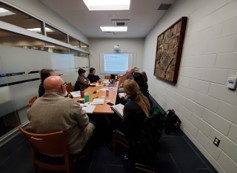 Over the last few weeks, the MEOPAR team has focused on ecosystem-based adaptation (EbA) and technology-based adaptation (TbA) options for Niagara in its blog posts. Since the role of communities is crucial in enabling action, today’s blog post will shed some light on some of the various community-based adaptation (CbA) strategies that have been found to be promising for Niagara’s agricultural sector.
Over the last few weeks, the MEOPAR team has focused on ecosystem-based adaptation (EbA) and technology-based adaptation (TbA) options for Niagara in its blog posts. Since the role of communities is crucial in enabling action, today’s blog post will shed some light on some of the various community-based adaptation (CbA) strategies that have been found to be promising for Niagara’s agricultural sector.
CbA is an adaptation approach that involves the participation of everyone in a community in all the steps of the adaptation process, from planning to implementation, with or without the help of external resources (such as researchers). It is usually referred to as a co-construction approach. CbA is based on social learning, capacity building and public engagement to define solutions that are locally appropriate and may later be integrated into various policy structures.
CbA strategies that use the co-construction approach have been applied to cereal (wheat, barley, oats and rye), oilseed (soybean, sunflower and canola) and vegetable (cabbage, tomato, potato, onions, peas) production in Canada. Rather than policy development, a much better coping capacity to extreme events can be developed with potentially greater social acceptability and implementation by applying a bottom-up co-construction approach. The MEOPAR-Town of Lincoln Climate Change Project is, in fact, based on this approach. This participatory approach can facilitate the inclusion of Niagara farmers in adaptation planning (especially to recurring droughts and floods).
CbA strategies can also involve the establishment of local farmers’ organizations that develop strategies to cope with climate change. These organizations can also play a critical role in the uptake and implementation of the latest technological innovations in agriculture, such as irrigation, tillage and storage.
Other larger organizations can also help to find solutions on a local level. For example, the ALUS (Alternative Land Use Services) Foundation has been actively involved in the domain of conservation agriculture (a type of EbA) in six Canadian provinces. The Foundation aims to protect ecological services that are important in farmlands and combines CbA with EbA, in order to help farmers become more resilient.
Institutions like Brock University, AAFC Vineland and Niagara College can also play a considerable role through extension and research collaborative activities. Research on improved climate-resilient crop varieties, multi-cropping, technological advancements and market diversification for produce, for example, has been suggested as a means for Niagara’s agricultural sector to adapt to climate change. Researchers can also help in taking a co-construction approach.
In summary, CbA strategies are relevant to Niagara’s agricultural sector and, combined with the other adaptation approaches, can help the sector better adapt to the impacts of climate change.
The researchers involved with the MEOPAR project are working to raise awareness about the impacts of climate change and how communities can effectively adapt and increase resilience to these changes. Follow along with our blog every week (written by researchers Liette Vasseur, Meredith DeCock, Bradley May, Pulkit Garg, Sam Gauthier & Jocelyn Baker) to learn more about the project and how you can get involved. You can also visit our website at brocku.ca/unesco-chair or email us at meopar-lincoln@brocku.ca
Caption: Examples of CbA application – MEOPAR Focus Group Meetings involving a co-construction approach (March, 2020)
‘AND’
Locally relevant research and partnerships with academic instituions is another relevant CbA strategy
‘AND’
Exploring potential partnerships with organizations like the ALUS Foundation can help develop strategies to cope with climate change



















